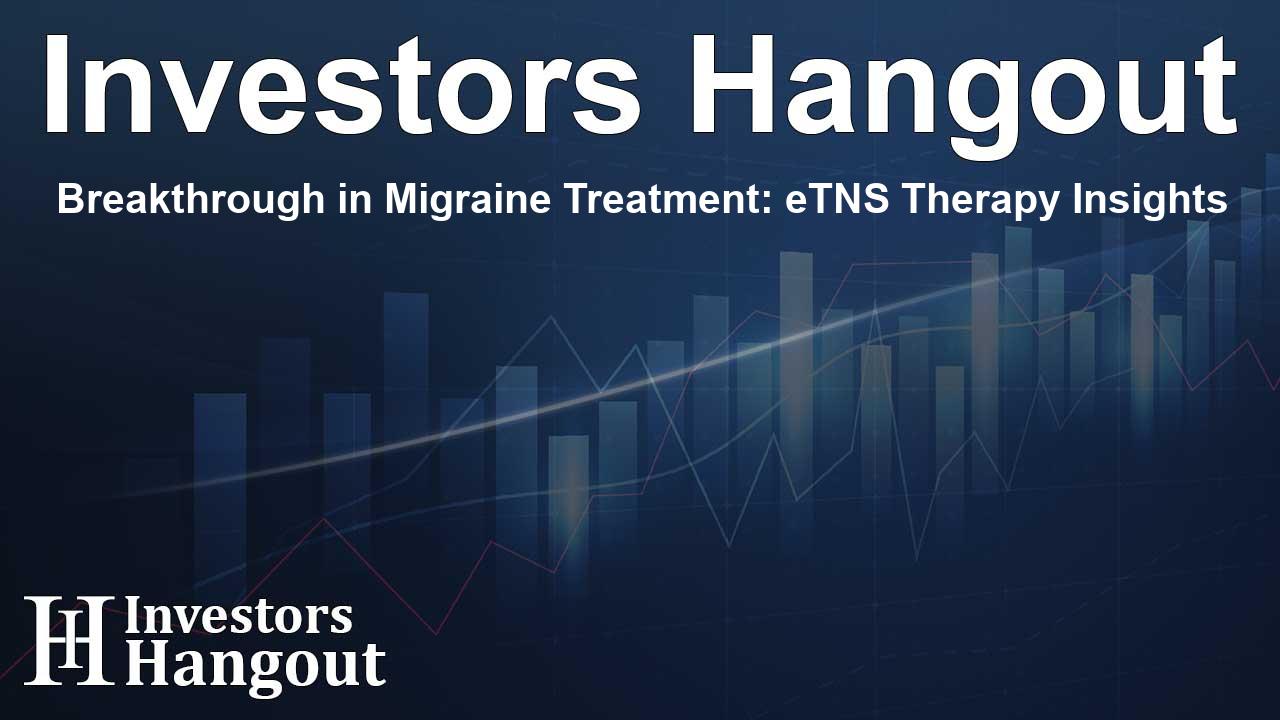Breakthrough in Migraine Treatment: eTNS Therapy Insights

Understanding eTNS Therapy for Migraine Management
Migraine management has taken a significant step forward with the introduction of external trigeminal nerve stimulation (eTNS) therapy. This innovative approach has been rigorously tested, demonstrating its potential effectiveness, particularly for patients suffering from specific bothersome symptoms (MBS) that often accompany migraines.
Key Insights from Recent Research
Research into eTNS therapy has revealed compelling evidence about its ability to address migrainous symptoms beyond just headache pain. A comprehensive analysis of the TEAM (Trial of eTNS for the Acute Treatment of Migraine) study provided foundational insights that underline the effectiveness of this therapy. Notably, eTNS therapy has shown to yield higher rates of pain freedom and an alleviation of MBS compared to traditional sham treatments.
Investigating Specific MBS and eTNS Effectiveness
The recent analysis delved deeper into the varied responses to eTNS therapy among different subtypes of MBS, particularly focusing on symptoms such as photophobia, phonophobia, and vomiting. It became apparent that patients experiencing light sensitivity (photophobia) and sound sensitivity (phonophobia) reaped substantial benefits from the therapy, showcasing marked improvements in pain relief and overall symptom resolution shortly after treatment.
Interestingly, those with nausea-related symptoms exhibited a more complex response trajectory. The results suggested that while eTNS provided certain levels of pain relief, these patients frequently required additional therapeutic interventions to achieve a satisfactory outcome.
The Challenge of Nausea as an MBS
Dr. Michael A. L. Johnson, a co-investigator in the study, emphasized the unique challenges faced by patients experiencing nausea as their MBS. He pointed out that these individuals might struggle significantly more concerning migraine relief than those suffering from other symptoms. This underscores the necessity for tailored treatment strategies that specifically address the nuances of each patient's experience.
Migraine: A Complex Condition
Migraine is a debilitating condition that impacts over a billion people around the globe. Despite its prevalence, there remains a considerable gap in understanding and addressing the varying symptoms associated with migraines. Many treatment protocols focus narrowly on headache relief, often overlooking the equally impactful effects of MBS, such as light and sound sensitivity, as well as nausea.
A recent survey found that around 79.8% of women reported nausea as a significant symptom. This highlights the necessity for healthcare providers to broaden their scope when considering treatment regimens for migraine sufferers.
Need for Further Research
The FDA has recommended that acute migraine treatments should prioritize addressing the most bothersome associated symptoms, reaffirming that successful migraine management goes beyond mere headache alleviation. With the knowledge that nausea can complicate treatment outcomes, further research is essential to fully understand these subtypes and improve treatment options.
Identifying the underlying causes of why nausea presents such a significant challenge for sufferers holds promising potential. Such investigations can enhance understanding and lead to improved management strategies that are personalized for different patient needs.
Where Do We Go from Here?
Dr. Deena Kuruvilla, the principal investigator, pointed out that clinical focus has often been skewed toward headache pain rather than the multi-symptomatic reality of migraines. The findings from the eTNS studies reiterate the importance of viewing migraine as a complex multifaceted condition that necessitates an empathetic and holistic approach to treatment.
The analysis of the TEAM study represents a notable stride in recognizing and addressing the varying needs of patients, particularly those dealing with nausea-associated migraines.
About CEFALY Technology
CEFALY Technology is at the forefront of advancing migraine treatment solutions. Their flagship product, CEFALY, is an FDA-cleared, over-the-counter wearable device that offers hope for those suffering from migraine-related issues. The company's commitment is to empower individuals managing migraines and enable them to lead healthy, fulfilling lives.
Frequently Asked Questions
What is eTNS therapy?
eTNS therapy involves the use of an external device to stimulate the trigeminal nerve, aimed at alleviating migraine symptoms.
How effective is eTNS treatment for specific MBS?
The treatment has shown effective results, particularly for light and sound sensitivity symptoms, with varied responses for nausea.
Why is nausea a challenging symptom in migraines?
Nausea can complicate migraine treatment, often requiring additional interventions for effective relief compared to other symptoms.
What does the FDA recommend regarding migraine treatments?
The FDA suggests including MBS as primary endpoints in clinical trials to ensure comprehensive evaluation of migraine treatments.
How can patients manage their migraine symptoms effectively?
Holistic approaches combining medication, lifestyle changes, and therapies like eTNS provide a well-rounded strategy for managing migraines and their associated symptoms.
About Investors Hangout
Investors Hangout is a leading online stock forum for financial discussion and learning, offering a wide range of free tools and resources. It draws in traders of all levels, who exchange market knowledge, investigate trading tactics, and keep an eye on industry developments in real time. Featuring financial articles, stock message boards, quotes, charts, company profiles, and live news updates. Through cooperative learning and a wealth of informational resources, it helps users from novices creating their first portfolios to experts honing their techniques. Join Investors Hangout today: https://investorshangout.com/
Disclaimer: The content of this article is solely for general informational purposes only; it does not represent legal, financial, or investment advice. Investors Hangout does not offer financial advice; the author is not a licensed financial advisor. Consult a qualified advisor before making any financial or investment decisions based on this article. The author's interpretation of publicly available data shapes the opinions presented here; as a result, they should not be taken as advice to purchase, sell, or hold any securities mentioned or any other investments. The author does not guarantee the accuracy, completeness, or timeliness of any material, providing it "as is." Information and market conditions may change; past performance is not indicative of future outcomes. If any of the material offered here is inaccurate, please contact us for corrections.